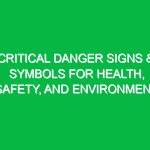In an increasingly complex world, understanding caution symbols is essential for ensuring health, safety, and environmental awareness. These symbols are visual representations that convey critical information about potential hazards, necessary precautions, and safety protocols in various settings. From workplaces to public spaces, the effective use of caution symbols can significantly reduce risks and promote a culture of safety. This article explores the key aspects of caution symbols in the Health, Safety, and Environment (HSE) domain, providing insights into their significance, applications, and relevant regulations.
Understanding Caution Symbols
Caution symbols serve a vital function in communicating important information quickly and effectively. They are designed to be universally recognizable, transcending language barriers to inform people of potential dangers. These symbols might indicate anything from chemical hazards to physical dangers, and they are essential in environments such as construction sites, laboratories, and public facilities.
At their core, caution symbols are a form of visual communication. They utilize colors, shapes, and icons to convey messages succinctly. For instance, a triangle often denotes caution; a red circle typically signifies prohibition, while a yellow background is commonly associated with warning signs. Understanding these symbols is crucial for anyone navigating environments where health and safety are prioritized.
The Importance of Caution Symbols in HSE
The Health, Safety, and Environment domain relies heavily on caution symbols to mitigate risks and enhance safety protocols. Here are some key aspects that highlight their importance:
- Risk Awareness: Caution symbols raise awareness about potential hazards. For example, the skull and crossbones icon warns of toxic substances, prompting individuals to take necessary precautions.
- Preventive Measures: By indicating specific risks, these symbols encourage proactive measures. A slip hazard sign, for instance, reminds individuals to tread carefully in wet areas.
- Compliance and Regulation: Many industries are required to display caution symbols as part of compliance with health and safety regulations. Non-compliance can lead to legal repercussions.
- Training and Education: Caution symbols are integral to training programs. New employees, for instance, learn to recognize these symbols as part of their orientation, fostering a culture of safety from the outset.
Types of Caution Symbols
Caution symbols can be categorized into several types based on their specific functions and the hazards they represent. Here are some of the most common categories:
Hazard Symbols
These symbols indicate specific hazards associated with materials or environments. Examples include:
- Biohazard: This symbol signifies the presence of biological substances that pose a threat to the health of living organisms.
- Corrosive: Represented by a test tube spilling a substance, this symbol warns of materials that can cause severe damage to skin or materials.
- Flammable: A flame icon indicates materials that can easily ignite and pose fire hazards.
Safety Instruction Symbols
These symbols provide instructions on how to behave in specific situations. Examples include:
- Wear Protective Equipment: This symbol indicates that personal protective equipment, such as gloves or goggles, is required.
- Emergency Exit: An exit sign directs individuals to escape routes in case of emergencies.
Warning Symbols
Warning symbols alert individuals to potential hazards. Examples include:
- Electric Shock Hazard: This symbol warns of electrical risks, reminding individuals to exercise caution around electrical equipment.
- Radiation Hazard: A trefoil symbol indicates areas where radiation is present, and protective measures are necessary.
Mandatory Symbols
These symbols indicate actions that must be taken to ensure safety. Examples include:
- Mandatory Eye Protection: This symbol indicates that eye protection must be worn in designated areas.
- Mandatory Hearing Protection: Signifies that hearing protection is necessary in noisy environments.
Real-Life Applications of Caution Symbols
Understanding the practical application of caution symbols can enhance awareness and safety in various environments. Here are a few real-life scenarios:
Construction Sites
Construction sites are inherently hazardous environments where caution symbols play a critical role. For instance, a “Caution: Hard Hat Required” sign ensures that workers wear helmets to protect against falling objects. Similarly, symbols indicating “Wet Floor” or “High Voltage” remind individuals to proceed with caution, fostering a safer work environment.
Laboratories
In laboratories, where chemicals and biological agents are prevalent, caution symbols are indispensable. A biohazard symbol alerts lab personnel to the presence of infectious materials, while a corrosive symbol warns of substances that can damage skin or equipment. These symbols not only protect workers but also visitors who might not be aware of specific hazards.
Public Spaces
Public spaces such as parks, shopping malls, and airports also utilize caution symbols. For example, a “Do Not Enter” sign is crucial for areas that may pose safety risks, such as construction zones or hazardous waste sites. These symbols ensure that the general public remains informed and safe.
Regulations and Standards Governing Caution Symbols
The effective use of caution symbols is governed by various regulations and standards, which aim to standardize safety practices across industries. Here are some key regulations:
Occupational Safety and Health Administration (OSHA)
In the United States, OSHA sets forth guidelines that require employers to use caution symbols to communicate hazards effectively. These regulations ensure that workplaces are safe and that employees are aware of potential risks.
Globally Harmonized System (GHS)
The GHS provides a standardized approach to classifying and communicating chemical hazards. Caution symbols play a significant role in this system, ensuring that labels are consistent and easily understood worldwide. This harmonization is crucial for companies operating in multiple countries.
International Organization for Standardization (ISO)
ISO standards also encompass the use of caution symbols in various industries. These standards aim to ensure that symbols are universally recognizable and clearly convey the intended message, promoting safety and awareness across borders.
Best Practices for Using Caution Symbols
To maximize the effectiveness of caution symbols, organizations should adopt several best practices:
- Visibility: Ensure that caution symbols are prominently displayed and easily visible to all individuals in the area.
- Clarity: Use symbols that are clear and easy to understand. Avoid overly complex designs that may confuse individuals.
- Regular Updates: Regularly review and update caution symbols to ensure they remain relevant and compliant with current regulations.
- Training: Provide training for employees and the public on the meaning and significance of caution symbols to foster a culture of safety.
The Future of Caution Symbols
As technology advances, the future of caution symbols may see further evolution. Digital signage and augmented reality tools are emerging as innovative ways to convey caution messages effectively. For instance, interactive signs could provide real-time information about hazards, enhancing safety in dynamic environments.
Moreover, as global communication continues to improve, the standardization of caution symbols across different regions will likely become more seamless. This will enhance safety for travelers and workers alike, ensuring that everyone can recognize and respond appropriately to potential hazards.
Conclusion
Caution symbols are essential tools in promoting health, safety, and environmental awareness. Their ability to communicate hazards effectively plays a crucial role in preventing accidents and ensuring compliance with regulations. By understanding and utilizing these symbols, organizations can foster safer environments for employees, visitors, and the general public.
As we move forward, it is essential to remain vigilant about the importance of caution symbols and their role in safeguarding our health and the environment. Whether through training, compliance with regulations, or the adoption of innovative technologies, we must prioritize safety and awareness in all aspects of life.


